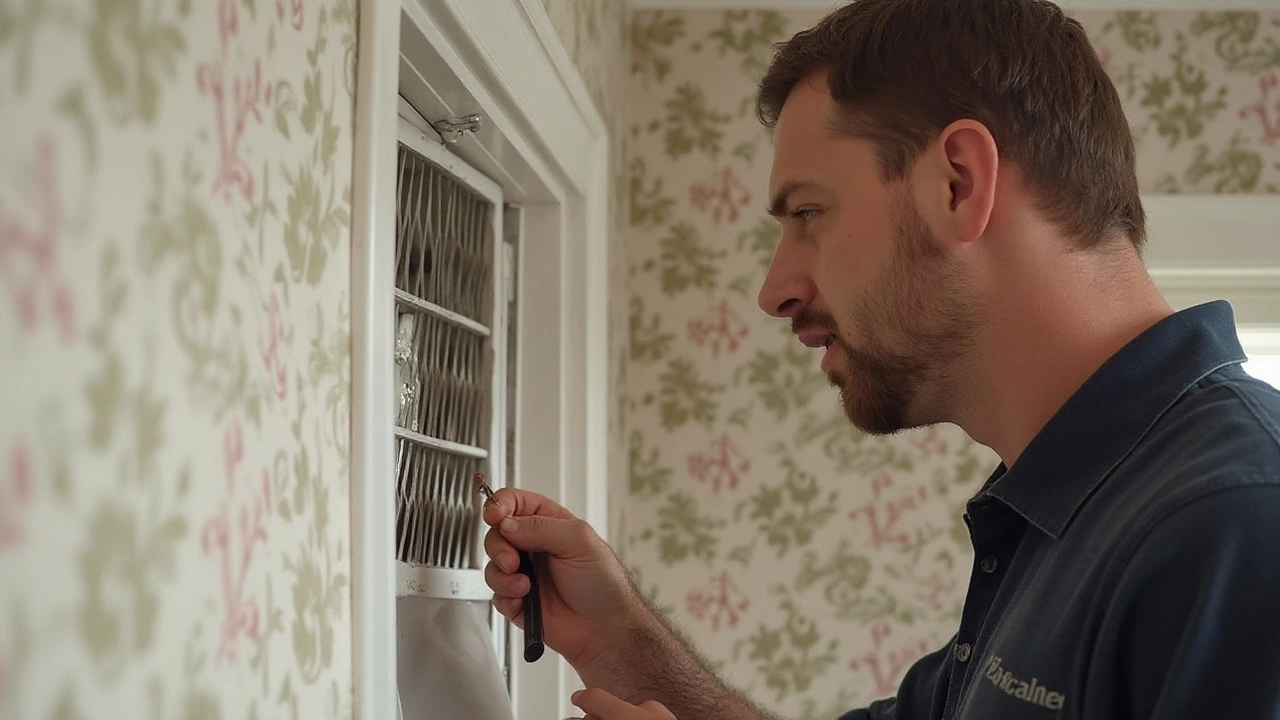Extractor fans, those unsung heroes in our kitchens, bathrooms, and industrial spaces, perform the simple yet essential task of banishing unwanted moisture and odors. While they often go unnoticed as they hum quietly in the background, these devices are key to maintaining healthy air quality. But how long can you expect them to serve you faithfully before they call it a day?
The longevity of an extractor fan greatly hinges on several factors, including its design, the environment it operates in, and most critically, how well it’s maintained. A fan that receives regular cleaning and maintenance is like a well-oiled machine, capable of running efficiently for many years.
In this article, we will delve into the components that impact the lifespan of these devices, offer practical tips to keep your fan in top condition, and point out the telltale signs that signal it's time to consider a repair or upgrade. By understanding these elements, you'll be equipped to maximize the performance and durability of an extractor fan in your space.
- The Function and Importance of Extractor Fans
- Factors Affecting the Lifespan of Extractor Fans
- Maintenance Tips for Prolonging Fan Life
- Signs It's Time to Repair or Replace Your Fan
The Function and Importance of Extractor Fans
Extractor fans, found in countless homes and businesses, carry out the critical task of refreshing our air by removing humidity, odors, and smoke. Think about the last time you cooked a hearty meal—maybe it was a curry or a grilled steak. These fans worked tirelessly to whisk away that persistent aroma, ensuring that your home didn't end up smelling like yesterday's dinner for the next week. Their primary job is to improve indoor air quality—an assignment they handle quite competently despite their often unremarkable appearance.
These devices are vital in areas with high humidity, like bathrooms and kitchens, as they prevent issues like mold growth and mildew, which can cause significant health concerns. Mold thrives in damp environments, and an extractor fan diligently clears airborne moisture, redirecting it outside before it can settle. In some environments, such as commercial kitchens or industrial settings, these fans are even more crucial as they help comply with health and safety standards. Think of them as silent custodians maintaining the harmony of our environments. According to the EPA, indoor air quality can be two to five times more polluted than outdoor air, making extractor fans not just convenient but necessary.
Key Functions of Extractor Fans
The specific function of an extractor fan varies slightly with its application, whether it's installed in a residential setting or a more industrial location. In essence, these fans operate by pulling unwanted elements out of a space, using a simple mechanism that involves a fan motor and blades. They capture and expel unwanted particles and gases, which might include smoke, steam, or dust. By keeping the air replenished, they also help regulate temperature, avoid overuse of air conditioning, and reduce energy costs, making them quite the energy-efficient solution in the long run.
For those skeptical about the real-world impact of these devices, consider this: the average kitchen extractor fan can clear a whopping 200 cubic meters of air per hour. That means it refreshes a moderate-sized room several times an hour—a capacity that's vital when dealing with the rapid build-up of steam and smells. No surprise then, that these seemingly humble machines are essential, especially in larger or heavily populated spaces.
"Good air quality is essential for good health." - American Lung Association
Understanding the critical role that extractor fans play in both domestic and commercial areas not only highlights their importance but also underscores the need for regular maintenance and repair to ensure they perform optimally. Without them, we would quickly find ourselves battling with unwanted scents, smoke, and dampness, which are not just nuisances, but hazards that can take a toll on our well-being.

Factors Affecting the Lifespan of Extractor Fans
Understanding the lifespan of an extractor fan involves taking a deep dive into various elements that play significant roles. One primary factor is the quality of the fan itself. High-quality fans, often constructed with durable materials and innovative designs, are engineered for longevity and continuous performance compared to their cheaper counterparts. The material of the blades and body often determines how well a fan can withstand the rigors of continuous use; metals like stainless steel are preferable due to their resistance to corrosion, especially in moisture-laden environments like kitchens and bathrooms.
An often underestimated aspect is the operating environment of these fans. Placed in areas like kitchens and bathrooms, they are frequently exposed to high humidity, fluctuating temperatures, and sometimes grease, all of which can corrode or otherwise wear down mechanical components over time. Environments with excessive dust or smoke can also clog filters, leading to the fan working harder than it should, potentially reducing its functional lifespan. Regular use in demanding settings necessitates more frequent maintenance, impacting both longevity and maintenance costs.
The frequency of usage is another contributing factor. A fan used intermittently will outlast one that's constantly running. Many fans come with ratings indicating expected hours of operation, and adhering to these guidelines can maximize their effective life. Labor-intensive uses, like in commercial kitchens or manufacturing setups, often result in shorter lifespans unless matched with appropriate industrial-grade equipment designed for such operations.
"A well-maintained fan can last anywhere from 10 to 15 years, but neglecting regular upkeep can reduce this by half," suggests Jake Thompson, an expert in home appliances at a leading energy conservation consultancy.
Maintenance practices play a pivotal role too. Cleaning both the fan blades and the surrounding areas prevents build-up that can cause the fan to over-exert, leading to wear and tear. Mechanical failures can be minimized by regularly inspecting parts for signs of stress, such as broken blades or motor issues, and addressing these before they escalate. Implementing a schedule for routine maintenance aligned with the manufacturer's recommendations can add years to the fan's lifespan.
The fan's repair history is another telling factor. An extractor that has undergone numerous repairs may indicate underlying issues that could threaten its longevity. Keep a record of any repairs and the parts replaced, as frequent issues in certain components might signal a need to replace the fan altogether rather than opting for another round of fixes. Recognizing these factors ensures that a fan will provide optimal performance and value over its intended lifetime.
Lastly, technological advancements bring about new features in modern fans designed to enhance longevity. Some models now incorporate smart sensors and automated cleaning mechanisms that help maintain optimal operational conditions without user intervention. Being mindful of these advancements can be beneficial when considering a new purchase, as these features can substantially reduce the burden of manual maintenance.

Maintenance Tips for Prolonging Fan Life
Regular maintenance is the key to ensuring that your extractor fans remain in good working condition for as long as possible. Just like any other mechanical device, these fans need a bit of attention and care to function optimally. One of the simplest yet most effective things you can do for your fan is to keep it clean. Dust and debris can accumulate over time, reducing efficiency and increasing wear. To clean your fan, first make sure it is turned off and unplugged. Remove any covers or grilles, and then use a damp cloth to wipe away the dust. For deeper cleaning, a vacuum cleaner with a hose attachment can be helpful for sucking out dirt from hard-to-reach areas.
Another important aspect of fan maintenance is checking the mounting and connections regularly. Over time, vibrations can cause screws and connections to loosen, which can lead to increased noise or even damage to the fan itself. Make sure that the fan is securely mounted and that all electrical connections are tight. If you notice any fraying or damage to the electrical wires, it’s best to call in a professional to handle the repairs. Safety should always be your top priority when dealing with electrical appliances.
Lubrication is also crucial to keep the fan running smoothly. Most fans have motor bearings that should be lubricated periodically. This not only ensures smooth operation but also prevents the motor from wearing out prematurely. Check the manufacturer's guide for the recommended type of lubricant and apply it as needed. This simple step can significantly increase the fan's longevity and efficiency. In some cases, an annual service by a professional can ensure that the fan runs smoothly, as they can spot problems before they become serious issues.
"Maintenance is the best strategy to extend the lifespan of any device," says John Anderson from Home Improvement Experts Weekly. "A well-maintained fan not only performs better but also consumes less power, saving you money in the long run."
For those in environments with high humidity, frequent use, or exposure to grease, such as kitchens or workshops, additional steps might be required. Consider installing filters or grease traps that can capture these particulates before they reach the fan components. This not only minimizes the buildup but also makes cleaning more manageable. Keeping an eye on the filters and cleaning or replacing them as needed can prevent overworking the fan. It's a small effort that pays off in extending the life of your fan.
In homes with children or pets, it's also wise to routinely inspect the fan and its surroundings for safety. Loose items or toys can easily get lodged into the blades, causing excessive strain or damage. Make sure the area around the fan is free of obstructions that could impede airflow or pose safety risks. By taking these proactive steps, you're not just maintaining a device; you're ensuring the well-being of your environment.

Signs It's Time to Repair or Replace Your Fan
Recognizing the signs that your extractor fan may need attention is crucial to maintaining a healthy living or working environment. As these devices age, they might show various symptoms indicating that a repair or even a complete replacement is necessary. One of the most obvious signs is unusual or excessive noise. If your fan suddenly starts sounding like a jet engine or produces grinding or screeching noises, it's a strong indicator that something is amiss. This can often be due to worn-out bearings or debris buildup, leading to friction and noise. Addressing such issues promptly can prevent more significant damage, ensuring the longevity of your fan.
Another telltale sign is a noticeable decrease in performance. If you realize that the fan isn't removing moisture or odors as effectively as it used to, it might be due to a blockage, a failing motor, or blades that have accumulated grime over time. Visual checks can often reveal dust and grease buildups that hinder its performance. Regular cleaning is usually enough to fix this, but in cases where the motor struggles due to age, replacement might be the only viable option.
Visible wear and tear such as cracks, rust, or warping on the fan housing or blades are also red flags. Such physical damage not only affects the aesthetics but also the efficiency of the fan. The structural integrity of the device could be compromised, posing a safety hazard. When rust or damage is apparent, a quick replacement ensures safety and optimal performance. Similarly, persistent electrical issues, such as flickering lights or random shutdowns, often signal the beginning of the end for your current fan. These are generally symptomatic of aging wiring or failing electrical components.
As noted by Home Appliance Doctor, "A consistent drop in efficiency often stems from neglected maintenance, leading to wear that simple repairs can't fix."Finally, if the energy bills present you with an unpleasant surprise month after month, your fan might be consuming more power than necessary. Older models tend to be less energy efficient, especially once they start showing age-related symptoms. In such cases, investing in a modern energy-efficient extractor fan could cut down on utility bills and provide more efficient performance, making it a cost-effective solution in the long run.
